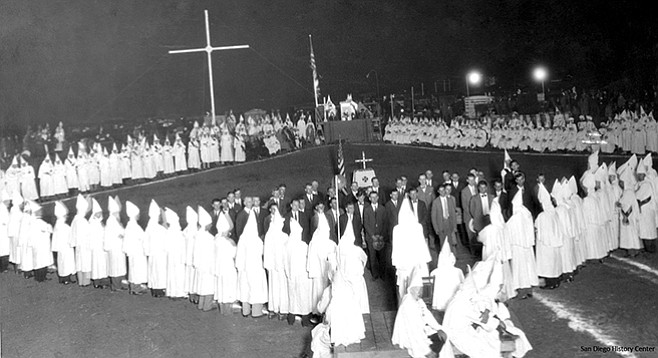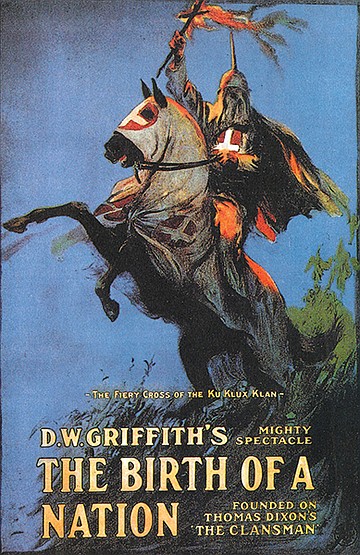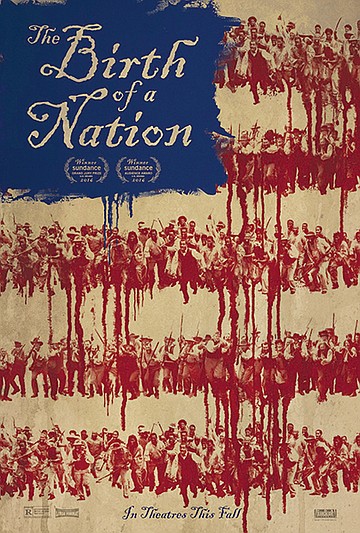 Facebook
Facebook
 X
X
 Instagram
Instagram
 TikTok
TikTok
 Youtube
Youtube

The Ku Klux Klan got rolling in the American South after the Civil War. Its aim was to thwart Republicans placing freed slaves in state legislatures and high government positions. The Klansmen of that period lynched black people, killed the blacks’ white supporters, and caused so much havoc that the Klan eventually was named a terrorist organization as militias pursued its members. That first period of the Klan was almost snuffed out.

Then, beginning in 1915, the Klan rose again, partly because of the popularity of a movie, The Birth of a Nation, which glorified the original Klan. (It is always reported that President Woodrow Wilson liked the film, but that was not true; he went out of his way to denounce it, although it was reportedly shown in the White House.)
Conservatively estimated, there were more than a thousand Klan members in San Diego in the 1920s. The group flourished, but not as intensively as in Los Angeles, where a mayor, police chief, and sheriff were Klansmen. It was in the 1920s when the unique costume came on the scene: floor-length white robe and a white pointed hood with eyeholes. Burning crosses also came in that second Klan period.
The San Diego Klansmen (and Klanswomen) of the 1920s were, generally, anti-Mexican, anti-immigration, anti-Chinese, anti-Catholic, anti-Semitic, anti-union, and anti-Communist. There were, however, some things that the San Diego Klan was for: Prohibition, rigid Protestantism, and white supremacy. Klansmen despised the loose morals of the Roaring ’20s, particularly the illegal imbibition in speakeasies.

Klan members, whose headquarters was a large hall west of 30th Street near Idaho Street in North Park, considered themselves morally superior. Indeed, an ad for the Klan Youth Corps, featuring a lad as clean-cut as a present-day Boy Scout, said the organization was for “white heritage, white pride, white unity, white power.” Said the ad, “If you are a White student between the ages of 12 and 17, and idealistically oriented toward the struggle for the survival of White Christian civilization, and values, then the Knights of the Ku Klux Klan invite you to become a part of the Klan Youth Corps.”

In the year 2000, scholars Carlos M. Larralde and Richard Griswold del Castillo (neither of whom I could reach) wrote a paper for the organization now known as the San Diego History Center. The name: San Diego’s Ku Klux Klan 1920–1980. The authors said, “In San Diego, the Ku Klux Klan particularly targeted Mexicans,” although it also aimed invective at new immigrants from Europe, Jews, and African-Americans. The monograph quoted a Mexican maid, who said, “Any Mexican worker who challenged authority or appeared suspicious of one thing or another would forfeit his life.” She told of seeing Mexican laborers being dragged and lynched or whipped and burned. Larralde and Griswold del Castillo stated, “Newspapers refused to investigate cases of Klan hatred because editors feared that negative publicity might create a bad image for San Diego and hurt its commercial growth.”
Colleen O’Connor, retired professor of history and sister of former mayor Maureen O’Connor, says the San Diego Klan of the 1920s “was [as] thuggish and brutal as in other cities.” O’Connor, who got her PhD in U.S. history at the University of California San Diego, says, “The KKK in San Diego, as elsewhere, was primarily a secret organization of white supremacists — bound by hate, prejudice, fear, and violence…above the law or often part of the law…who cloaked themselves not just in white hooded sheets but in a polluted form of patriotism that was an attempt to mask the base nature of their cruelty.”
San Diego’s Klan of the 1920s was strongly anti-union. The often violent mentality of the local battle that in 1912 pitted the business establishment, clergy, media, and others against the Industrial Workers of the World (called Wobblies) may have carried over to the Klan of the 1920s, suggests O’Connor. “The anti-union sentiment that still exists here probably did have its roots in the Wobblies era. And the white supremacist nature of the Klan still exists in U.S. politics today,” says O’Connor.
The major paradox is that for all its violence and hatred, the 1920s Klan was considered moderately reputable, particularly in the South and parts of the Midwest. In relative population, Indiana was the biggest Klan state. Nationwide, the Klan’s population reached 4 million in the mid-1920s. It was politically powerful. Its massive marches in big cities chilled politicians, executives, and scholars who might speak out against it.
In the 1920s, “San Diego had been a Southern town for a long time,” and that was even more true of Los Angeles, says Steve Erie, professor emeritus at the University of California San Diego, where he taught both political science and history. “A lot of Southern sympathizers after the Civil War settled in Los Angeles,” and that spread to San Diego and other parts of Southern California, but that doesn’t mean the Southern influence by the 1920s was a major power in the local Klan. Like O’Connor, Erie believes that “there was some carryover from the 1912” anti-union violence that sunk into the 1920s San Diego Klan.
We have to look at the times, says Erie. Nationwide, there was a “linkage of immigration with radicalism.” This was a time of syndicalism, a revolutionary doctrine by which workers would seize control of the economy and government, says Erie. “It was the first Red Scare.” Bolshevism and trade unionism were linked in many minds. The Palmer Raids against suspected leftists were carried out by the Department of Justice. The Sacco-Vanzetti trial wrongly convicted two immigrant radicals. “The KKK had their own radio stations — they were the ultimate purveyors of fake news.”
O’Connor points out that some of the so-called respectable people who belonged to the Klan in San Diego were doing so to get or retain a job from the boss, a Klansman.
Since that 1920s period, some people seem to have forgotten the Klan’s brutality. In 1978, the organization now known as the San Diego History Center interviewed V. Wayne Kenaston Jr., whose father was Kleagle (recruiter) of the San Diego Klavern of the Klan in the early 1930s. The family was Protestant, and his father belonged to the Masons as well as the Klan. His mother made him a child’s Klan outfit. In the interview, Kenaston stated that members of the Klan that he knew were not necessarily anti-Catholic. They were opposed to the Catholic hierarchy. Similarly, Klan members from that period weren’t really anti-Mexican. “The Klan was chasing the wet-backs across the border,” he said.


The Ku Klux Klan got rolling in the American South after the Civil War. Its aim was to thwart Republicans placing freed slaves in state legislatures and high government positions. The Klansmen of that period lynched black people, killed the blacks’ white supporters, and caused so much havoc that the Klan eventually was named a terrorist organization as militias pursued its members. That first period of the Klan was almost snuffed out.

Then, beginning in 1915, the Klan rose again, partly because of the popularity of a movie, The Birth of a Nation, which glorified the original Klan. (It is always reported that President Woodrow Wilson liked the film, but that was not true; he went out of his way to denounce it, although it was reportedly shown in the White House.)
Conservatively estimated, there were more than a thousand Klan members in San Diego in the 1920s. The group flourished, but not as intensively as in Los Angeles, where a mayor, police chief, and sheriff were Klansmen. It was in the 1920s when the unique costume came on the scene: floor-length white robe and a white pointed hood with eyeholes. Burning crosses also came in that second Klan period.
The San Diego Klansmen (and Klanswomen) of the 1920s were, generally, anti-Mexican, anti-immigration, anti-Chinese, anti-Catholic, anti-Semitic, anti-union, and anti-Communist. There were, however, some things that the San Diego Klan was for: Prohibition, rigid Protestantism, and white supremacy. Klansmen despised the loose morals of the Roaring ’20s, particularly the illegal imbibition in speakeasies.

Klan members, whose headquarters was a large hall west of 30th Street near Idaho Street in North Park, considered themselves morally superior. Indeed, an ad for the Klan Youth Corps, featuring a lad as clean-cut as a present-day Boy Scout, said the organization was for “white heritage, white pride, white unity, white power.” Said the ad, “If you are a White student between the ages of 12 and 17, and idealistically oriented toward the struggle for the survival of White Christian civilization, and values, then the Knights of the Ku Klux Klan invite you to become a part of the Klan Youth Corps.”

In the year 2000, scholars Carlos M. Larralde and Richard Griswold del Castillo (neither of whom I could reach) wrote a paper for the organization now known as the San Diego History Center. The name: San Diego’s Ku Klux Klan 1920–1980. The authors said, “In San Diego, the Ku Klux Klan particularly targeted Mexicans,” although it also aimed invective at new immigrants from Europe, Jews, and African-Americans. The monograph quoted a Mexican maid, who said, “Any Mexican worker who challenged authority or appeared suspicious of one thing or another would forfeit his life.” She told of seeing Mexican laborers being dragged and lynched or whipped and burned. Larralde and Griswold del Castillo stated, “Newspapers refused to investigate cases of Klan hatred because editors feared that negative publicity might create a bad image for San Diego and hurt its commercial growth.”
Colleen O’Connor, retired professor of history and sister of former mayor Maureen O’Connor, says the San Diego Klan of the 1920s “was [as] thuggish and brutal as in other cities.” O’Connor, who got her PhD in U.S. history at the University of California San Diego, says, “The KKK in San Diego, as elsewhere, was primarily a secret organization of white supremacists — bound by hate, prejudice, fear, and violence…above the law or often part of the law…who cloaked themselves not just in white hooded sheets but in a polluted form of patriotism that was an attempt to mask the base nature of their cruelty.”
San Diego’s Klan of the 1920s was strongly anti-union. The often violent mentality of the local battle that in 1912 pitted the business establishment, clergy, media, and others against the Industrial Workers of the World (called Wobblies) may have carried over to the Klan of the 1920s, suggests O’Connor. “The anti-union sentiment that still exists here probably did have its roots in the Wobblies era. And the white supremacist nature of the Klan still exists in U.S. politics today,” says O’Connor.
The major paradox is that for all its violence and hatred, the 1920s Klan was considered moderately reputable, particularly in the South and parts of the Midwest. In relative population, Indiana was the biggest Klan state. Nationwide, the Klan’s population reached 4 million in the mid-1920s. It was politically powerful. Its massive marches in big cities chilled politicians, executives, and scholars who might speak out against it.
In the 1920s, “San Diego had been a Southern town for a long time,” and that was even more true of Los Angeles, says Steve Erie, professor emeritus at the University of California San Diego, where he taught both political science and history. “A lot of Southern sympathizers after the Civil War settled in Los Angeles,” and that spread to San Diego and other parts of Southern California, but that doesn’t mean the Southern influence by the 1920s was a major power in the local Klan. Like O’Connor, Erie believes that “there was some carryover from the 1912” anti-union violence that sunk into the 1920s San Diego Klan.
We have to look at the times, says Erie. Nationwide, there was a “linkage of immigration with radicalism.” This was a time of syndicalism, a revolutionary doctrine by which workers would seize control of the economy and government, says Erie. “It was the first Red Scare.” Bolshevism and trade unionism were linked in many minds. The Palmer Raids against suspected leftists were carried out by the Department of Justice. The Sacco-Vanzetti trial wrongly convicted two immigrant radicals. “The KKK had their own radio stations — they were the ultimate purveyors of fake news.”
O’Connor points out that some of the so-called respectable people who belonged to the Klan in San Diego were doing so to get or retain a job from the boss, a Klansman.
Since that 1920s period, some people seem to have forgotten the Klan’s brutality. In 1978, the organization now known as the San Diego History Center interviewed V. Wayne Kenaston Jr., whose father was Kleagle (recruiter) of the San Diego Klavern of the Klan in the early 1930s. The family was Protestant, and his father belonged to the Masons as well as the Klan. His mother made him a child’s Klan outfit. In the interview, Kenaston stated that members of the Klan that he knew were not necessarily anti-Catholic. They were opposed to the Catholic hierarchy. Similarly, Klan members from that period weren’t really anti-Mexican. “The Klan was chasing the wet-backs across the border,” he said.
Comments